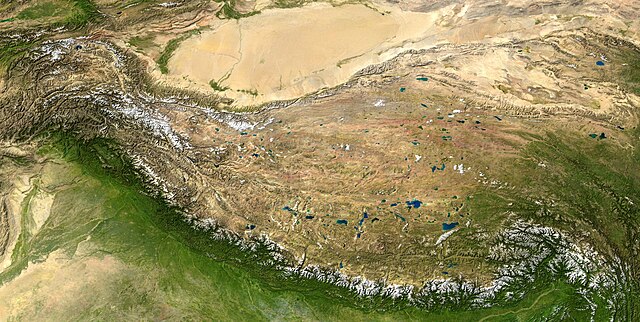The Tibetan Empire was an empire centered on the Tibetan Plateau, formed as a result of imperial expansion under the Yarlung dynasty heralded by its 33rd king, Songtsen Gampo, in the 7th century. The empire further expanded under the 38th king, Trisong Detsen, and expanded to its greatest extent under the 41st king, Rapalchen, whose 821–823 treaty was concluded between the Tibetan Empire and the Tang dynasty. This treaty, carved into the Jokhang Pillar, delineated Tibet as being in possession of an area larger than the Tibetan Plateau, stretching east to Chang'an, west beyond modern Afghanistan, and south into modern India and the Bay of Bengal.
A statue of Emperor Songtsen Gampo in a cave at Yerpa
The Tibetan Empire in 700 AD
Copper-plated Sakyamuni Buddha statue during First dissemination
The bilingual text of peace treaty inscribed on the Tang-Tibetan alliance stele, Jokhang temple.
The Tibetan Plateau, also known as Qinghai–Tibet Plateau and Qing–Zang Plateau, is a vast elevated plateau located at the intersection of Central, South, and East Asia covering most of the Tibet Autonomous Region, most of Qinghai, western half of Sichuan, Southern Gansu provinces in Western China, southern Xinjiang, Bhutan, the Indian regions of Ladakh and Lahaul and Spiti as well as Gilgit-Baltistan in Pakistan, northwestern Nepal, eastern Tajikistan and southern Kyrgyzstan. It stretches approximately 1,000 kilometres (620 mi) north to south and 2,500 kilometres (1,600 mi) east to west. It is the world's highest and largest plateau above sea level, with an area of 2,500,000 square kilometres (970,000 sq mi). With an average elevation exceeding 4,500 metres (14,800 ft) and being surrounded by imposing mountain ranges that harbor the world's two highest summits, Mount Everest and K2, the Tibetan Plateau is often referred to as "the Roof of the World".

The Tibetan Plateau lies between the Himalayan range to the south and the Taklamakan Desert to the north. (Composite image)
Yamdrok Lake is one of the four largest lakes in Tibet. All four lakes are considered sacred pilgrimage sites in the local tradition.
Natural-colour satellite image of the Tibetan Plateau.
Yangbajain valley to the north of Lhasa








